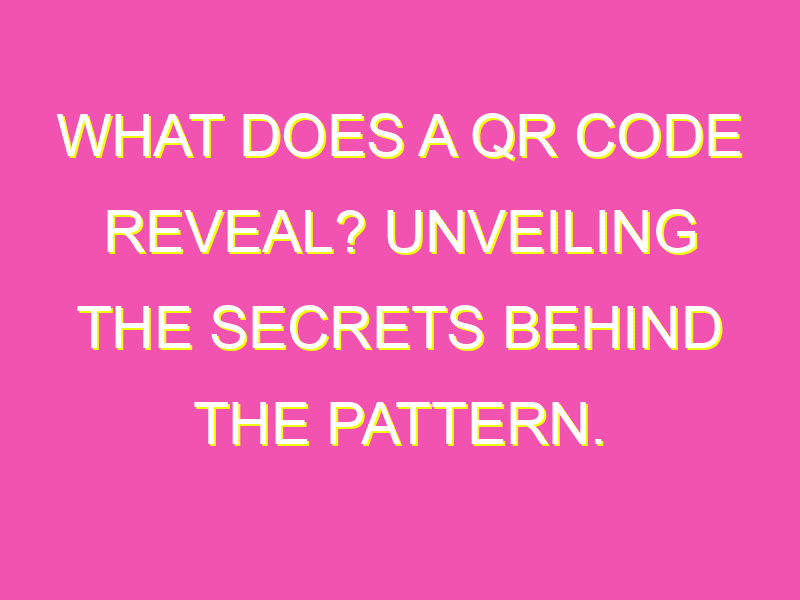Looking for an efficient way to access information in today’s fast-paced world? Look no further than the QR code! With its small square frame, QR codes pack a big punch, holding a plethora of data ranging from website URLs to product details and more. But it’s not just about storage capacity – QR codes are also quick and easy to scan, making them an ideal tool for marketing or sharing important information. And let’s not forget how they’ve revolutionized payment systems – simply scan and you’re done! The potential of QR codes is limitless, and it’s exciting to think about all the ways they can continue to streamline our access and sharing of information.
Understanding QR Codes: Definition and Meaning
Quick Response or QR codes are simple, two-dimensional barcodes used to store information that can be easily scanned by a smartphone or a QR code reader. Invented in Japan in the early 1990s, QR codes were originally created to track inventory in the manufacturing process. Since then, they have become widely popular in advertising, marketing, and other industries as a way to provide access to information instantly. QR codes have been successful in bridging the gap between offline and online marketing, allowing businesses to connect with their customers quickly and easily.
The Hidden Potential of a QR Code
QR codes are small in size but can store a lot of information, including website URLs, product information, contact details, and much more. They are not limited to just data storage but can also be used to trigger actions such as opening a website or downloading an app. QR codes can be customized with logos, colors, and shapes, making them more visually appealing and easier to recognize. Additionally, they can be printed on various materials such as magazines, flyers, posters, and even on physical products.
Unlocking Information with QR Codes
QR codes have the power to connect people with information instantly. They offer instant gratification to consumers by providing them with access to information they need or want. For instance, scanning a QR code on a product may provide product information, reviews, and a link to purchase the product online. Scanning a QR code on a restaurant menu can display the menu, prices, and even allow the customer to place an order. QR codes can also be used in businesses to connect with customers by providing them with promotional offers, coupons, and loyalty rewards.
- Quick response: QR codes are quick and easy to scan, providing consumers with fast access to information.
- Flexible: QR codes can be printed on various materials including business cards, signs, and products.
- Trackable: QR codes can be tracked to measure their effectiveness and how often they were scanned.
- Customizable: QR codes can be customized with colors, shapes, and logos.
Quick and Easy Access: The Purpose of QR Codes
The primary purpose of QR codes is to provide quick and easy access to information for consumers. A QR code can be scanned with a smartphone camera or a QR code reader, which takes the user directly to the information stored in the code. QR codes save consumers time and effort by not having to type in URLs or search for information. They also ensure that the information provided to consumers is accurate and up to date.
QR Codes: Storing More than Just Data
QR codes are not just limited to storing data but can also be used for authentication and security purposes. QR codes can be used for two-factor authentication, allowing access to secure accounts only after the user scans the code with their smartphone. They can also be used to store personal information, such as contact details, medical information, and emergency contacts.
The Power of Quick Response: How QR Codes Work
QR codes work by using a pattern of black and white squares to store information. The amount of information that can be stored in a QR code varies depending on the size and complexity of the code. When a user scans a QR code, the smartphone or QR code reader app interprets the pattern and accesses the information stored within the code. QR codes can store different types of information including text, URLs, and even multimedia files such as videos and images.
The Evolution of QR Codes and Their Applications
Since their invention in the early 1990s, QR codes have evolved and become more popular. QR codes are being used in a variety of industries, including healthcare, automotive, and retail. In healthcare, QR codes are being used to provide access to patient records and medication information. In automotive, QR codes are being used to provide access to manuals, repair guides, and other documentation. In retail, QR codes are being used to provide product information, promotions, and discounts.
In conclusion, QR codes are a powerful tool for businesses and consumers alike. The ability to provide quick and easy access to information has made QR codes an essential part of marketing and advertising strategies. Their ability to store information, trigger actions, and track user engagement has made them a valuable asset for businesses of all sizes. As technology continues to advance, we can expect to see new and innovative uses for QR codes in the future.





